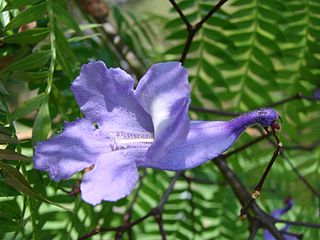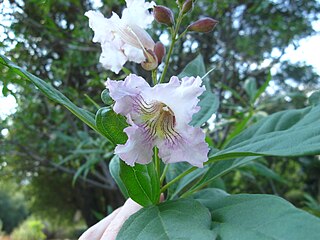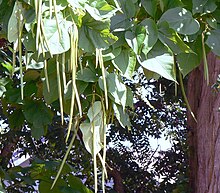
Tabebuia is a genus of flowering plants in the family Bignoniaceae. Tabebuia consists almost entirely of trees, but a few are often large shrubs. A few species produce timber, but the genus is mostly known for those that are cultivated as flowering trees.

The Elaeagnaceae are a plant family, the oleaster family, of the order Rosales comprising small trees and shrubs, native to temperate regions of the Northern Hemisphere, south into tropical Asia and Australia. The family has about 60 species in three genera.

Bignoniaceae is a family of flowering plants in the order Lamiales commonly known as the bignonias or trumpet vines. It is not known to which of the other families in the order it is most closely related.

Campsis radicans, the trumpet vine, yellow trumpet vine, or trumpet creeper, is a species of flowering plant in the trumpet vine family Bignoniaceae, native to eastern North America, and naturalized elsewhere. Growing to 10 metres, it is a vigorous, deciduous woody vine, notable for its showy trumpet-shaped flowers. It inhabits woodlands and riverbanks, and is also a popular garden plant.

Chaenomeles is a genus of four species of deciduous spiny shrubs, usually 1–3 m tall, in the family Rosaceae. They are native to Southeast Asia. These plants are related to the quince and the Chinese quince, differing in the serrated leaves that lack fuzz, and in the flowers, borne in clusters, having deciduous sepals and styles that are connate at the base.

Metrosideros is a genus of approximately 60 trees, shrubs, and vines mostly found in the Pacific region in the family Myrtaceae. Most of the tree forms are small, but some are exceptionally large, the New Zealand species in particular. The name derives from the Ancient Greek metra or "heartwood" and sideron or "iron". Perhaps the best-known species are the pohutukawa, northern and southern rātā of New Zealand, and ʻōhiʻa lehua, from the Hawaiian Islands.

Jacaranda is a genus of 49 species of flowering plants in the family Bignoniaceae, native to tropical and subtropical regions of the Americas while cultivated around the world. The generic name is also used as the common name.

Ceratomia catalpae, the catalpa sphinx, is a hawk moth of the family Sphingidae. The species was first described by Jean Baptiste Boisduval in 1875. Other common names are the Catawba worm, or Catalpa sphinx.

Chilopsis is a monotypic genus of flowering plants containing the single species Chilopsis linearis. It is known commonly as desert willow or desert-willow because of its willow-like leaves, but it is not a true willow – being instead a member of the catalpa family.

Catalpa speciosa, commonly known as the northern catalpa, hardy catalpa, western catalpa, cigar tree or catawba, is a species of Catalpa native to the midwestern United States.

Lagerstroemia speciosa is a species of Lagerstroemia native to tropical southern Asia. It is a deciduous tree with bright pink to light purple flowers.

Catalpa bignonioides is a short-lived species of Catalpa that is native to the southeastern United States in Alabama, Florida, Georgia, Louisiana, and Mississippi. Common names include southern catalpa, cigartree, and Indian-bean-tree. It is commonly used as a garden and street tree.

Prunus speciosa, the Oshima cherry, Japanese オオシマザクラ, is native to Izu Ōshima island and the Izu Peninsula on Honshū near Tokyo, Japan.

×Chitalpa is an intergeneric hybrid flowering tree in the family Bignoniaceae. There are two major forms in North America, the 'Morning Cloud' a hybrid of desert willow for desert hardiness and color, and northern catalpa, and the 'Pink Dawn' variety formed as a hybrid of desert willow and either yellow catalpa or northern catalpa. Both forms were originally thought to be hybrids of desert willow and southern catalpa. The name is nothogeneric, or a combination of the two parents' names. Leaves are lanceolate, 10 to 13 cm long and 2.5 cm (1 in) wide, almost always in whorls of three. The trumpet-shaped flowers are 2.5 cm (1 in) long and frilly. The inflorescence is indeterminate, with alternately arranged flowers.

Indigofera australis, the Australian indigo or Austral indigo, is an attractive species of leguminous shrub in the genus Indigofera. The genus name Indigofera is Neo-Latin for "bearing Indigo". The specific epithet australis, from the Latin, means not “Australian” but "southern", referring to the geographical distribution of the species.

Catalpa ovata, the yellow catalpa or Chinese catalpa, is a pod-bearing tree native to China. Compared to C. speciosa, it is much smaller, typically reaching heights between 20 and 30 feet. The inflorescences form 4–10-inch-long (100–250 mm) bunches of creamy white flowers with distinctly yellow tinging; individual flowers are about 1 inch (25 mm) wide. They bloom in July and August. The leaves are very similar in shape to those of Paulownia tomentosa, having three lobes, and are darkly green. Fruits are very narrow, foot-long pods.

Catalpa bungei, commonly known as Manchurian catalpa, is a species of catalpa native to China. The specific epithet honors the botanist Alexander Bunge, who collected the specimens that Carl Anton von Meyer later described. The flowers are arranged in a corymb and are densely spotted with pink. It is cultivated in China, along with C. ovata, for its wood, which is also used for coffins, ancestral tablets, and oars. It also used as an ornamental tree.

Aloe speciosa is a species of flowering plant in the Asphodelaceae family. It is commonly called tilt-head aloe and is an arborescent aloe indigenous to the thicket vegetation of the southern Cape Provinces of South Africa.

Catalpa × erubescens, the hybrid catalpa, is a hybrid plant species of Catalpa in the family Bignoniaceae. It is a medium-sized tree, reaching at most 20 m. Its parents are southern catalpa, Catalpa bignonioides, from the United States, and yellow catalpa, C. ovata, from China. There is one accepted form, Catalpa × erubescens Carrière f. purpurea Paclt, which has purple, some say chocolate-colored, young leaves which turn green as they mature. This form is marketed under a variety of names, such as hybrid catalpa 'Purpurea', red-leaved Indian bean tree, and purple hybrid catalpa, and has gained the Royal Horticultural Society's Award of Garden Merit.

Catalpa fargesii, the Chinese bean tree, is a species of tree in the family Bignoniaceae, native to China. Growing to about 25 m tall, it is a deciduous tree which produces abundant pink blossom in spring, followed by narrow brown beans-like fruit in the autumn. Some sources place the species as a synonym of Catalpa bungei.






















